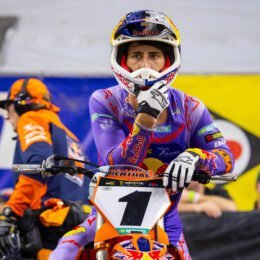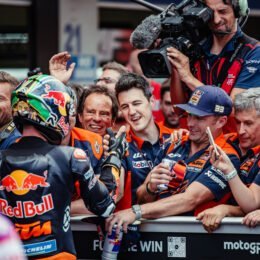Interview of the month: Harald Plöckinger, KTM COO
We continue to put the board of directors under the spotlight and this month we catch up with the 55 year old Chief Operating Officer to talk some nuts and bolts of KTM.
Harald Plöckinger welcomes us into his spacious and bright office in Mattighofen. His workspace is diligently ordered and free of clutter. He greets us with a smile that barely seems to fit in the large room and proves to be a polite, expressive and considered talker, even apologizing for the use of the sole soft swearword that escapes his lips through a forty minute conversation. Plöckinger’s pride for KTM and the advances made by the company in targeting the production of 200,000 motorcycles in Mattighofen is easily evident.
He might have his finger on the pulse with regards to how the company actually make the bikes appear on the street and dirt but we’re also interested in how the Austrian managed to arrive to this position of control in the first place.
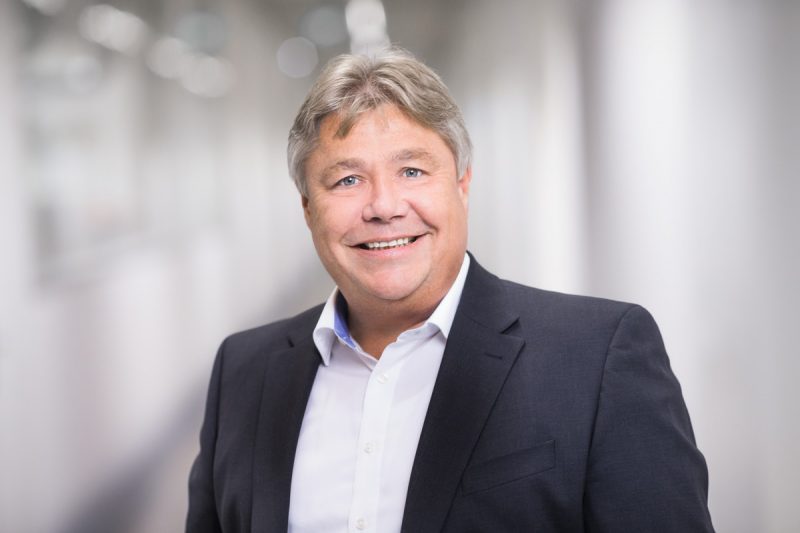
Harald Plöckinger (AUT) 2016
“I’m a mechanical engineer and went to technical college and had training that involved engine building and vehicle engineering,” he explains. “I did a degree in the same subject at university in Graz and had my first job at BMW in the engine development section. I was there for four years but after a few months I had the luck to be involved in a very interesting project for serial production that was the 2.5 diesel turbo engine. I did the thermodynamic development and emissions.”
Plöckinger then had the chance to work for Canadian firm Bombardier-Rotax and this is where his career headed into operation production and by his early thirties he was leading an engineering and technician´s group of more than 100 people. It was also where he had his first taste of the orange. “Rotax had been a supplier for KTM with crankshafts and transmissions, especially for offroad engines and also the LC4 was based a little bit on a Rotax design of the late ‘80s. So there were always a few connecting points between the companies and during 2003 we started talking about sport ATV engines. BRP wanted a 450 and obviously there was already one in the motorcycle. I met Stefan Pierer in Wels and asked if we could do something together. Rotax was a vendor and now we wanted to buy something from KTM.”
So how did you find your way to Mattighofen on a permanent basis?
“We had started discussions, then Rotax and the whole recreational sector were sold by the parent company Bombardier. This was in December 2003 and signs were pointing to change. I talked some more with Mr. Pierer and looked into KTM as a company. In March 2004 I started research in the range of engine building/purchase. Until July I worked out a concept for these two areas and this was the starting point for my time with KTM.”
What did you find through the investigation and what did you think of KTM before you joined?
“Well, the name was well known in Austria. You had Puch and KTM as the two famous motorcycle brands. It was clear that KTM in Mattighofen was the offroad brand that was lightweight and with good engines. I had known the company through this vendor-and-customer relationship so there was also this knowledge about the product itself – not so much about the complete bike but the engines of course – and it was not a big surprise for me when I came here because there was already some familiarity. The thing that surprised me here was this ‘pushing to the edge’ with the technology. It was more than I had seen anywhere else, especially in the car environment at BMW; you just don’t do that. You have to go for total durability. Also on the recreational side I had not seen such a big emphasis on racing and competition before. I felt this was the biggest difference when I came to KTM. By designing more ‘on the edge’ in terms of the material you choose and the wall thicknesses and weight it felt like this was all new to me.”

Carlos Rivera, Harald Plöckinger, Troy & Ryan Dungey, Pit Beirer & Stefan Pierer KTM 450 SX-F East Rutherford (USA) 2016
How did you find the different cultures of BMW, the Canadians and then to KTM? Not just from the technology but also the philosophy and the methodology …
“Also on the development side. And processes. It was something that was very focused with the Canadians: to be on time, on cost. This was a bit ‘grey’ when I arrived here so to structure new product development process was something on-hand. The challenge was to make the organization aware that this was not only a task for R&D. It is something that starts in R&D but must move right through to customer service.”
When you arrived at KTM did you find quite a big task ahead?
“No. You cannot come in and say ‘I’m the big prophet and you must follow me’. It has to come from the organization. So you have to sit, you have to talk and make people aware of what could be done. You cannot do it with a standardized method that has come from outside of the company. You have to do it as part of the company culture … with the orange bleeders we have here.”
In your career with KTM you had the bloom under the initial Pierer years, the cuts of economic crisis and then the re-emergence of KTM. How was it moving through those periods?
“In the three phases the first was to create methodologies, processes – as I said – and then also a little in terms of actual products. Then the crisis came and the orientation changed totally. We had to manage ourselves as a company but also from the vendor to the dealer. It was all about cash, liquidity and how can we resist. Like many others we were asking ‘how deep will this fall? When does it stop?’ At the end of the day we said – and this is probably one of the main factors behind the recent success – we did not want to stop the development focus. We may have slowed some projects but we did not stop with any of them and that helped in the time directly after the crisis. When the economy turned up again we were there and ready to go with new products and be the first on the market.”
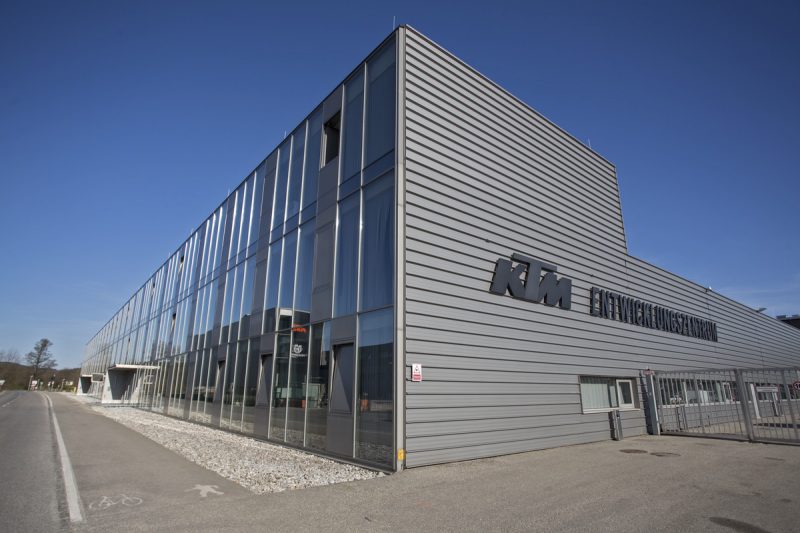
KTM research & development building
Was that difficult though? To go into meetings and ask that cuts are not made even though the company was hurting … ?
“It was incredibly difficult. For example in R&D we built up a thermodynamics group to do proper calculations and emission assessment of engines and all of a sudden you have to stop because costs in R&D need to be cut. We did not want to stop projects but those cuts had to be made so there were some tough decisions. People were hired and then let go without any reflection on their work it was simply because changes had to happen.”
How was it then to manage re-expansion when KTM could start prospering again?
“We started from a low point after the crisis. We went back to something like 60,000 units that we had in the factory and this year it’ll be 136,000. So we have more than doubled in that period from 2011, just five years. The capacity was there because the four assembly lines were still in place and in the crisis we were only operating three. We added people again. At the end of the day when you hit your maximum with four lines in a single shift then you start thinking about what can be done better on the line. This is what I always ask my production people: we don’t want people to work harder, we want them to work smarter. We took away all the operations from the line that didn’t add value or efficiency. So the people there could focus on assembling products and giving good productivity but also good quality because they don’t have to work around different elements with boxes and other materials. They can just have their tools and components and we take care of the rest on the outside. This is one way in which we could increase output from all four lines and in one shift. We did this until 2014 and when we reached a point where we needed to go into a second shift. Today we have four shifts in the morning and two in the afternoon, so six and we still have two left to go. We now have developed a plan called ‘2020’ [shuffles a set of papers on his desk in a booklet]. This is more or less a book that shows the changes that we have in mind from this summer until the summer of 2018 and 2019. There will be a lot of changes in the setup of the plant here to support logistics. We will still have four lines but an output of 200,000. By 2020, 200,000 is the target. The same is true for the engine factory.”
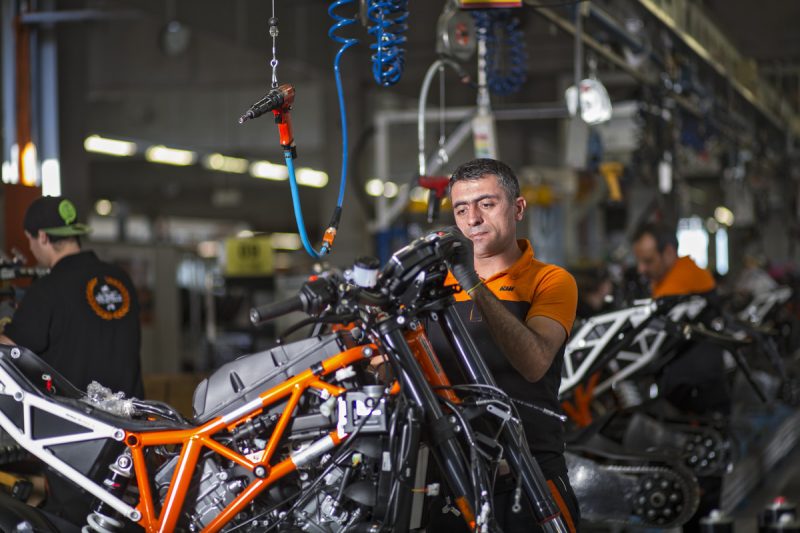
KTM assembly
I’m guessing that book took a bit of time to put together …
“[laughs] Yes! It is not something you can do in a moment. You have to throw the balls in the air, let them come down and look at the way they can be arranged. It took just over a year to look at all the points where we can improve and then how we can properly organize. We also learn day-by-day and what we might have learned by 2019 means the plan could change.”
How do you feel about the Bajaj chapter of the KTM story?
“Ah, a nice one. I had contacts with India in my old company so I knew a little bit about the motorcycle market there and what demands could come from an Indian partner (and in technology especially). We were having discussions here about how we could develop entry-level street bikes and how we could produce them in a way so they are competitive in the market and worth carrying the KTM brand. I was telling my colleagues about the Indian market and co-incidentally we had a request for a meeting from Bajaj. I remember we were in Geneva presenting the X-BOW for the first time at the Autoshow and the same evening we had the first meeting with the Bajaj people. Two months later we were on a plane to Mumbai to visit them. The collaboration turned out to be a great success. It was another learning experience for our organization because it was with a partner that was far away and with a totally different culture, language and different methodology. We started to define what could be a first model or product to do together and it was the 125/200 DUKE; the 125 with the European market in mind and the 200 for the Indian market because we knew when we brought over new technology with the liquid cooling and fuel injection that the costs compared to a typical Indian product would be higher so we had to go higher in cc to be competitive. Then we had to learn how to work together! And synchronize processes and even the way the companies are managed together because India is very hierarchical. If the head of R&D doesn’t agree with something then you can talk for years to the people beneath him and it still will never proceed. I think we did well together and it [the deal] opened doors for KTM into regions where we wanted to go and had the products to do it. You need entry-level products to help the dealers in these markets survive at the end of the day.”
Apart from maintaining product development and associations with the likes of Bajaj were there any other elements to explain KTM’s success over the last half a decade? Maybe a landmark project?
“No. It’s the people, I would say. I learned that in this area there is a long tradition of building motorcycles – more than sixty years – and it might take a little while to get ‘into’ this group but once you are ‘in’ then you are ‘in’. This is a family and is another secret of KTM. When there is a ‘need’ then nobody will really question the way to go. We just do it together and that is one of the major strengths of the company. The SUPER DUKE was probably one of these milestones and also when we launched the new LC8 engine which was much more powerful and capable than the older one and with modern technology to boast good strength. At the development phase we put some ‘reserves’; the working title was ‘1200’ but at one point in time we decided let’s put that reserve in place because we could need that 100cc in the future. I think the 1290 SUPER DUKE R was extremely important for KTM but also in the street motorcycle world.”
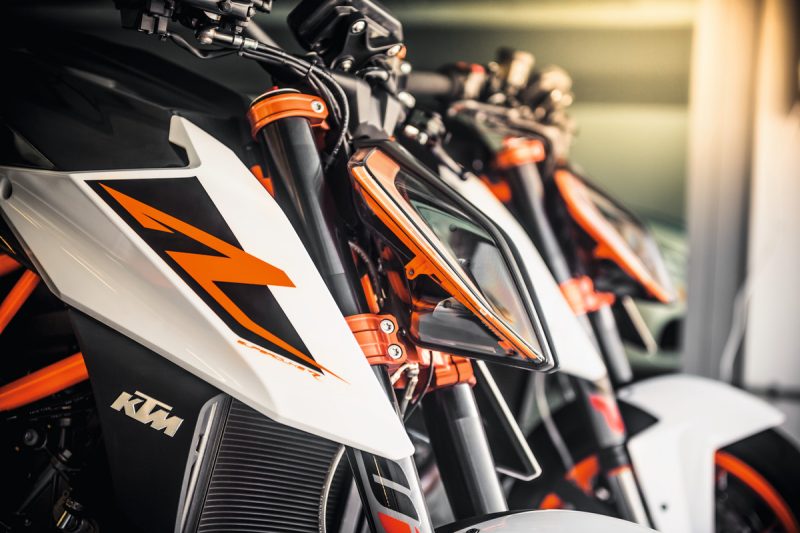
KTM 1290 SUPER DUKE R MY2017
We’ve spoken about some of the good times but was there a moment in the past few years where it seemed like KTM was nearing a red line? That the company was pushing too hard and very fast?
“Not looking back but instead to the present and the near future I think the [pressing] subject is people again. We need to find the right people because we still have projects and growth in mind. It is becoming more and more difficult.”
Why?
“First of all the brand is good, and in this area of Austria there is probably no other company for a young person to choose. You have the emotion, the product, the culture and organization but you need more and more dedicated and specialized people for digitalization, electronics and safety systems on the bikes these days. You need the right trained staff in these areas. It is a big market [of employment] and I think location comes into it. Maybe engineering needs more than one base in the future. We already have development work going on in Salzburg at Kiska’s place and maybe there is another one coming soon.”
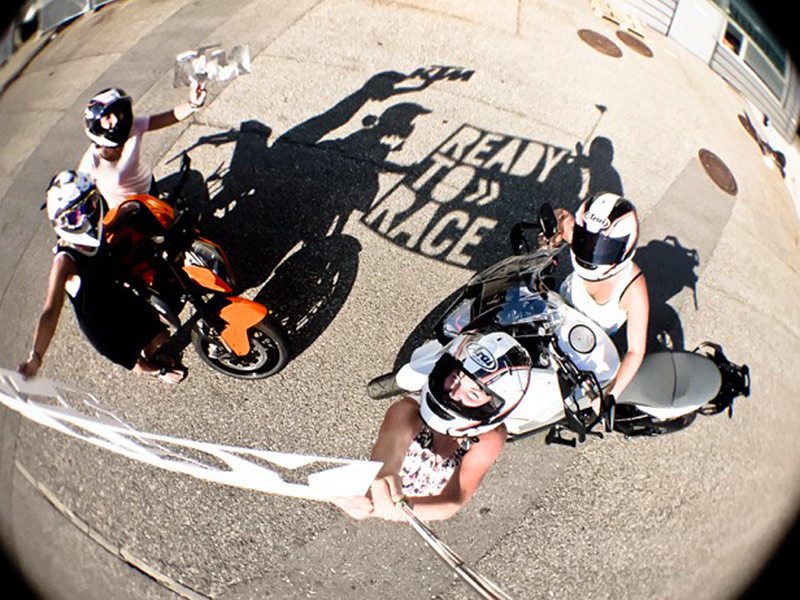
KTM employees
What about R&D? KTM have gone from this plucky and adventurous company to one with considerable heft when it comes to advanced engineering. The growth there in particular had been impressive …
“Absolutely and I would say in the beginning it was a way in which we were behind our competitors in terms of electronics and even fuel injection; when I first came here the first ADVENTURE still had an engine with carburetor . But things developed quickly and ABS came in as standard and the next ADVENTURE was a breakthrough. We were able to say ‘hey, we have sport motorcycles and fast motorcycles but we also have safety systems and riding aids’. Besides the traditional advances made by R&D this other element is something that has grown very fast and brought us to the position where we are today. KTM have gone there with a lot of speed.”
Racing: it has been excellent for marketing but has it also been very valuable for development?
“In offroad no question, definitely. When you go racing on the dirt and give the feedback to engineers in R&D then it can be reflected in the product directly because they are very close to each other. OK, there are different materials and weight optimization between race and production models but we say ‘out of the box, you can race’. READY TO RACE is what it is all about. When we do have issues – and we do have them at times – with some serial products then they are probably known in racing beforehand. So racing is important for R&D in offroad. For street, we don’t have comparable products to a Moto3 bike or the RC16 today with any road legal product. We can still do things and test things that might come into production later but the gap is much wider compared to a series motorbike. Road racing is very important for marketing however. It demonstrates the technical capabilities of KTM. We have some technology that could make its way to the [assembly] lines in the future.”
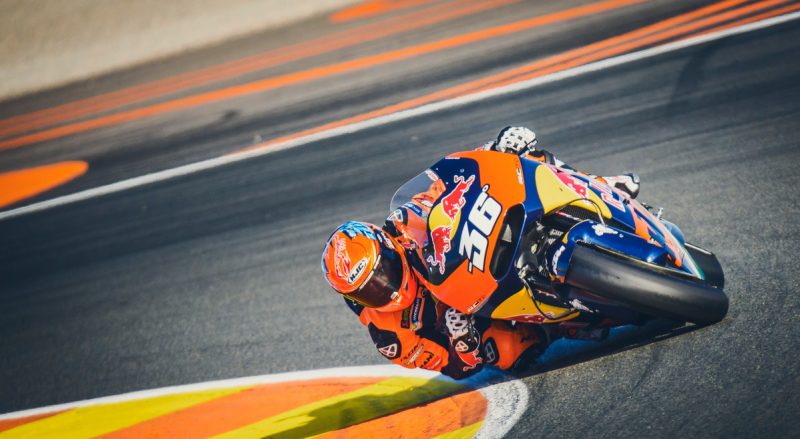
Mika Kallio (FIN) KTM RC16 Valencia (ESP) 2016
Racing has been part of the success and coupled with the models has made KTM a very attractive brand. How else can you explain that orange is so cool?
“You have to look back in time and when KTM ‘restarted’ in ’92 it was purely an offroad brand and remained so until the early ‘00s. Then the street models came. READY TO RACE was cultivated in that offroad prime and then we had those four core values: PURITY, PERFORMANCE, ADVENTURE and EXTREME and the strict focus on that is what has made KTM what it is perceived today. Can we make something that is retro-styled or a bit soft under the KTM brand? No. We would give up the ‘contact’ and the heritage. It is also a limiting factor but then Husqvarna comes into the picture and it is a perfect combination. We have a second brand where we can share technology and platforms but on the street side we can do products totally different to what we could do with the KTM brand. Coming back to your question it is the clear focus and picture for the KTM bikes – offroad or street – and also the communications to the customer and even down to the shop design, which will be similar whether you are in Argentina or China or India.”
Could you tease some details of what KTM customers, fans or followers might expect from the brand in the next fives years?
“We don’t have the full line-up on the street side so we saw the hole plugged for the biggest segment globally with the 790 DUKE. There is room for a Naked Bike, an ADVENTURE bike and maybe something else. Keep the higher end and the lower end and focus on the middle.”
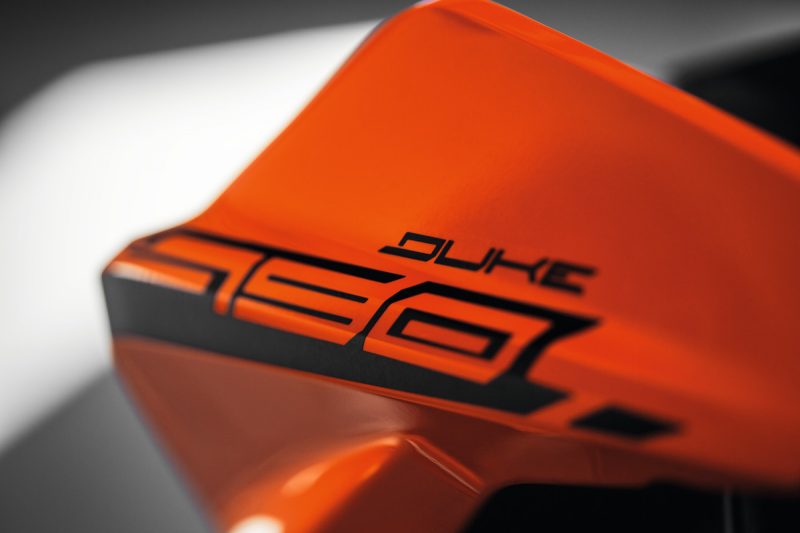
KTM 790 DUKE prototype
How has your job changed over the years? More travel?
“Globalization brings travel! That’s fine! The partnership with Bajaj – considering that we are about to launch a new generation of DUKEs – has been more intensive in that respect. The bigger influence today is with the base suppliers because we still have some companies that have not come out of the crisis fully and they can give some headaches at points in time. For example a rim manufacturer in Germany went bankrupt last year in the middle of the high season for production and you have to manage [the fallout] from that. Unfortunately you also have natural disasters in the world like the recent earthquake in Japan and the flooding in Thailand. You have to manage the situations from a global supplier base. Back to Europe and we are facing another problem with a vendor who was taken over by a financial investor who increased prices dramatically. The attitude and the way communications is evolving in business is getting a little rougher; this is more challenging rather than travelling or developing a 2020 book!”
Lastly what’s in the garage?
“A 690 DUKE R! My seventeen year old boys have the 125s; one has an RC and the other one has a DUKE.”
Photos: KTM


